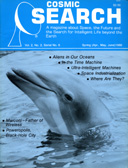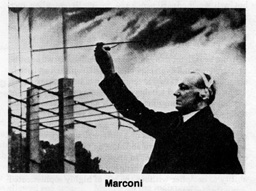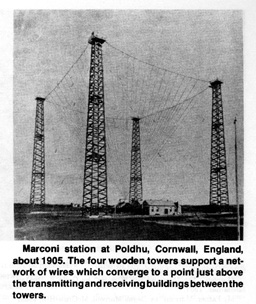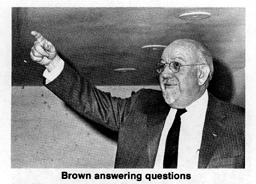![[NAAPO Logo]](../../Images/NAAPOsm.jpg) North American AstroPhysical Observatory (NAAPO)
|
|
Marconi
By: George H. Brown
After Marconi received the first trans-Atlantic radio signals at St. John's, Newfoundland, in December, 1901, and later, after the value of wireless at sea had been dramatized by the S.S. Republic and S.S. Titanic disasters, Marconi was regarded with a universal awe and admiration seldom matched. Before wireless, complete isolation enshrouded a ship at sea. Disaster could strike without anyone on the shore or nearby ships being aware that anything head happened. Marconi changed all that.
In 1894, twenty year old Guglielmo Marconi learned of Heinrich Hertz's pioneering experiments with electric waves, or Hertzian waves as they were then called. Within a few years Marconi had added an antenna and ground, tuned circuits and other improvements and turned what had been a laboratory curiosity into a practical communication system. Marconi became the wizard of the air waves.
On July 24, 1937, four days after the death of Senatore Marconi, I was installing a directional antenna system for Radio Station WSMB in New Orleans. I was sitting beside a road many miles from the transmitter with a pair of headphones and a radio receiver equipped for measuring the strength of the radio signal. Suddenly I heard an announcement of a program to be broadcast—"The Human Side of Marconi"—followed by voices of a number of my friends and professional associates. One of the speakers was H. E. Hallborg, at that time an engineer with RCA Communications. He related that in 1912 he was one of a
group of American Marconi engineers sent to Ireland to study the huge Marconi transmitter near Clifden on the Connemara peninsula. Day after day while they were in the Clifden station, they would see Mr. Marconi come to the station with mysterious packages under his arm. Sometimes these would prove to be a new form of spark gap or a jigger for receiving, and the next step would be to try his device in practice.
One cold rainy night, Mr. Marconi came in quite unexpectedly, having walked several miles from the railway station, but carrying the usual package—this time unusually large. Everyone eagerly watched the unwrapping. It was not a condenser this time or a new magnetic detector, but instead a dozen phonograph records.
"I thought you young men from the States might be rather lonely out here," said Mr. Marconi rather shyly, "so I brought you some graphophone records."
So saying, he placed the first one on the machine and the homesick Americans thrilled to the strains of "Everybody's Doing It Now".
A few years ago, my wife and I, accompanied by two grandsons, set out to see what remained of the historic Clifden transmitting station. After much questioning in Clifden, we finally encountered one elderly citizen who was able to direct us south on the narrow coast road. About four miles from Clifden, we found the bog, unencumbered by signs except one which stated "ROAD NOT SUITABLE FOR MOTOR VEHICLES." Somewhat of an understatement for the two ruts plunged into a lake several feet in depth. In the distance, we spied one concrete tower base and a pile of rust which appeared to be the remains of an alternator. Closer to us was a vertical steel rail about three feet tall, the last remaining relic of the Marconi light railway.
On a nearby hillside stands a white stone in the general shape of an aircraft tail fin, erected by Aer Lingus. This memorial points to a white cairn a mile away in the bog where the Alcock-Brown aircraft landed. In the town, another memory of the aviators stands as the Alcock and Brown Hotel. But not a sign to tell one of the fifteen years when the giant Marconi transmitter linked the British Isles with North America. Two photographs in my old copy of "The Principles of Electric Wave Telegraphy and Telephone" by J. A. Fleming show the huge engine and boiler house, the large condenser house, the giant antennas, and even a commodious residence for the operators. It is a shock to realize that only a concrete block, a steel rail, and a pile of rust remains.
My interest in Marconi's life and career finally led me and my wife to visit Bologna. First, we walked past the Marescalchi Palace on Via IV Novembre where Marconi was born. Then we proceeded to the Villa Grifone which was his boyhood home and where he conducted his first experiments. While we were viewing the mausoleum at the foot of the hill near the road, a caretaker informed our taxi driver that the villa or house was undergoing repairs and visitors were not permitted to enter. The taxi driver did not know what to do with this information for he was no more able to speak English than was the caretaker. When I addressed the caretaker in her own language, she beamed at us and suggested that we drive to the top of the hill to visit the house and take coffee with her. This we did and we found the house being completely refurbished, with a large meeting room being prepared for technical conferences and a laboratory being re-established on the top floor. It is a magnificent building with high ceilings, marble floors, and huge fireplaces. The fields around, on a high plateau, fade off in the distance to a series of rolling hills, affording an excellent location for radio-propagation experiments.
A marble commemorative tablet on the front wall of the house, facing the village of Pontecchio, is inscribed:—
"Marconi—The Man and His Wireless" by Orrin E. Dunlap, MacMillan, 1937.
"My Father, Marconi" by Degna Marconi, McGraw-Hill, 1962.
The first book goes more into Marconi's technological achievements while the second reveals more of his personal life.
Born in North Milwaukee, Wisconsin, in 1908, he attended the University of Wisconsin receiving three degrees from the institution: bachelor's in 1930, master's in 1931 and Ph.D. in 1933. The same year he received his doctorate he joined the Radio Corporation of America, serving at Camden and Princeton, New Jersey, until his retirement in 1973, in positions ranging from Chief Engineer of the Commercial Electronics Division to Vice President for Research and Engineering.
Dr. Brown has received many honors and awards including an honorary Doctor of Engineering degree from the University of Rhode Island (1968), the Edison Medal of the Institute of Electrical and Electronic Engineers (1967) and the DeForest Audion Award (1968). In 1974 he was Marconi Centenary Lecturer of the American Association for the Advancement of Science.
He has long been active in boy scout affairs, serving on the executive board of the George Washington Council of the Boy Scouts of America (BSA) and is the recipient of the Silver Beaver and Silver Antelope awards of the BSA. He is author of numerous articles in scientific journals and is coauthor of the book "Radio Frequency Heating". Recently, Dr. Brown has completed the manuscript for a book on some highlights of his extremely productive career.
[NOTE. Some photographs from The Marconi Company in England arrived too late to accompany this article. They are presented in a separate article in Issue 7 (Summer 1980) entitled "More Marconi". Here is a link to that article: Link to "More Marconi". — Webpage Editor]
|




